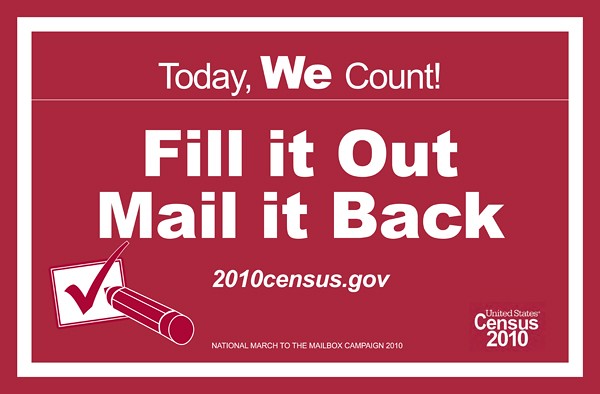Starr: An Efficient Census is Necessary For Effective Democracy

A March to the Mailbox rally sign from the 2010 Census. (Courtesy Flickr)
October 1, 2019
When the Constitution was drafted and ratified by the Founders, they decided that direct taxation and each state’s number of representatives would be determined by population. The apportionment procedure is codified in the Constitution under Article 1, section 2 and was modified with the passage of the 14th Amendment in section 2 to better include people beyond white men. “The whole number of persons in each State” determines representation, and because of this, we all should be watching the incoming 2020 Decennial Census closely. Adequate funding is crucial to obtaining an accurate count of people, especially the populations which are isolated and systemically ignored.
Since the first census in 1790, the nationwide count occurs every 10 years. It is intended to empower people politically, provide data to aid the fair distribution of funds and help businesses and cities operate with functionally in a data-driven manner. The “short” census form is received by most households and collects basic information about age, race, gender and the total number of people living in the United States. The “long form” gathers deeper information related to economic and social data such as ability status, income and level of education.
Long-form information is more useful for economic development measures and social program placement and funding — both forms are critical for the democratic process. Questions on both forms have changed over time, and the inclusion of certain inquiries, the placement thereof and the specific wording can impact response rates and therefore the direction of services, funding and the allocation of representatives.
Representation by the House of Representatives is more democratic than the Senate, and it’s determined by the population count to ensure an equitable distribution of seats. Power is proportionate to the population in the House, unlike the Senate, which guarantees each state two senators. As the population shifts, House seats are created or combined, and the political affiliation of their representatives impacts policy. For example, Utah gained another house seat after the 2010 Census, which increased its political capital. Projections show that after the 2020 count, 10 seats will change across 16 states throughout the country.
After the census results are in, redistricting begins to better reflect population changes in order to achieve proportional representation. Therefore, the information from the Census is vital and the state legislatures redraw most congressional boundaries. These legislators should be informed by data, not by the majority party’s desire to cling to power through gerrymandering. Regular participation in elections is obviously important, but participation in the census is an under-looked form of representation.
Having a seat at the table during the making of important decisions is the foundation of democracy, but the census does more than divide up the 435 House seats. Population data has a big influence on where more than $675 billion per year of federal money goes. These funds are the necessary lifeblood for schools, hospitals and infrastructure projects. The data collected about sex and race can be important tools for helping mitigate race and sex discrimination. According to the Population Reference Bureau, a nonprofit specializing in population and health data analysis, census data can assist government and communities in ensuring equal opportunity. Gathering information may seem like a basic way to promote equity, but it is a truly practical measure to forward social justice goals when the data is explored and utilized.
The wording of ethnicity and race questions can have large impacts on data collection and resource allocation. Questions need to be based on what we know in terms of response rates. For example, the third-largest racial group found in both the 2000 and 2010 census was “some other race” because folks were not finding their group amongst the categories. Future questions need to gather the most reflective data as possible.
Here in Utah, the state legislature has funded the 2020 counting effort through a bill that grants $1 million for “Census Outreach,” a smart funding choice by the state. Efforts to count people in rural areas of Utah will be a major priority, as well as “populations of lower socioeconomic status, racial and ethnic minority communities and aging populations.” A detailed plan about how to best procure the relevant data will come in November.
Representative democracy, the direction of federal and state funds, redistricting and social justice are contingent on the census. Efforts to count all people living in the United States needs to be well funded and well-staffed. While giving everyone the opportunity to mark their race and note their sex may seem like a fairly empty task for a bureau to complete, it’s one of the many nuts and bolts of a well-oiled democracy.







